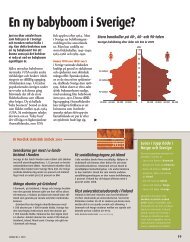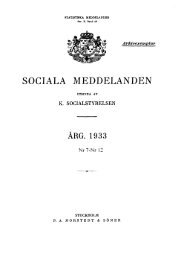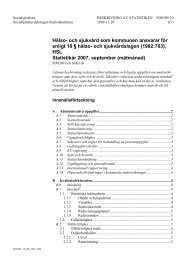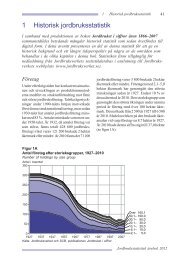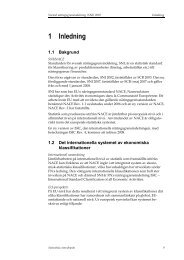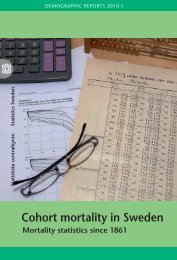Perspektiv på välfärden 2004 (pdf) - Statistiska centralbyrån
Perspektiv på välfärden 2004 (pdf) - Statistiska centralbyrån
Perspektiv på välfärden 2004 (pdf) - Statistiska centralbyrån
Create successful ePaper yourself
Turn your PDF publications into a flip-book with our unique Google optimized e-Paper software.
Youth<br />
Introduction<br />
Young people have always been subject to concern<br />
related to their youth, both with respect to<br />
‘disturbing’ youth culture and behaviour<br />
(Lindgren 2002) as well as to how social changes<br />
affect the transition into adulthood (Bynner, Chisholm<br />
and Furlong 1997; Jones and Wallace 1992).<br />
These concerns seem justified, as youth is a formative<br />
transition phase, signified by a successive<br />
move through the educational system, labour<br />
market establishment and family formation, that<br />
hopefully, considering the alternative, everybody<br />
will go through. It is furthermore a period that for<br />
many is signified by unemployment, economic<br />
hardship, uncertainty about the future and insecurity<br />
about one's own ability to handle the situation.<br />
Young people are also, increasingly it seems,<br />
being pinpointed as losers who lag behind older<br />
generations, i.e., the middle aged, with regard to<br />
economic prosperity and career opportunities (cf.<br />
Häll and Vogel 1997; Vogel 1994). The problem<br />
with this reasoning, when repeated over time, is<br />
that those who were young losers twenty years<br />
ago are middle-aged winners today, or to be more<br />
correct, some of them are winners and some are<br />
still losers. It is consequently clear that we should<br />
focus, not only on the conditions among the<br />
young at one point in time, but first and foremost<br />
on the long-term impact of conditions prevailing<br />
during adolescence. However, although the problems<br />
young people face have been thoroughly<br />
discussed in the literature, we know relatively<br />
little about the long-term impact of these problems.<br />
As a result, we lack the knowledge necessary<br />
to determine whether our worries about<br />
young people and their future are justified, and<br />
perhaps even more important, to determine<br />
whether we are worried about the right things.<br />
The aim of this study is therefore to analyse the<br />
degree to which circumstances during adolescence<br />
affect future income development and the<br />
incidence of economic difficulties in adult life. To<br />
do so, we use a panel sample that was first interviewed<br />
in the beginning in the 1980s when the<br />
panel members were between 19 and 25 years old.<br />
A second panel wave was completed eight years<br />
later, and the final wave after sixteen years.<br />
Hence, the panel covers 16 years and at the third<br />
wave, the respondents were between 35 and 41<br />
years old.<br />
Young and poor<br />
It is more or less a given fact that a substantial<br />
portion of young people have low incomes<br />
(Salonen 1993; Salonen 2000). The temporality of<br />
this situation is in most cases also more or less<br />
given; income mobility and changes in economic<br />
68<br />
standard are, for example, immense among those<br />
below the age of thirty, compared to the middle<br />
aged (Björklund 1993). However, there is more<br />
than just a gap between the young and the rest of<br />
the population. Since the 1970´s, the development<br />
of young people's incomes has been lower than<br />
for the rest of the population (Torége 1997). The<br />
main explanation for this development is a general<br />
social change resulting in prolonged education,<br />
in combination with increasing youth unemployment,<br />
leading to a general postponement of<br />
labour market establishment (Banks et al. 1992;<br />
Bynner, Chisholm and Furlong 1997; Jones and<br />
Wallace 1992).<br />
Knowing that many young people have low incomes<br />
does not mean that we know they actually<br />
also suffer from economic hardship and a low<br />
economic standard, i.e., that they have to forgo<br />
vital consumption, have problems making ends<br />
meet and live in economic insecurity. First, the<br />
economic standard is not primarily determined by<br />
the individual’s income, but by the household’s<br />
disposable income and the number of people assumed<br />
to share that income. Thus, as long a<br />
young person stays in the nest, he/she can be assumed<br />
to share at least the common consumption<br />
within the household (housing, food, equipment,<br />
such as TV etc.) 1 . For example, comparison of the<br />
situation in different European countries shows<br />
that young people in Sweden and other Scandinavian<br />
countries are, in relation to the middle aged,<br />
relatively worse off compared to the young in<br />
central Europe and, even more so, in comparison<br />
to those in Mediterranean countries (Vogel 2002).<br />
The main reason for this is that young people in<br />
the northern part of Europe leave the nest earlier<br />
than do those in southern Europe. Second, even<br />
though a young person has left the nest, it is possible<br />
that there is a substantial flow of economic<br />
resources from the parents to the child, again obscuring<br />
the relationship between income and economic<br />
standard. It is possible to make a long list<br />
of circumstances that blur the relationship between<br />
income and standard of living (cf. Halleröd<br />
2000), making it clear that it is important that we<br />
1 Swedish income data have long been hampered by an<br />
incomplete household definition. As soon as a person<br />
turns eighteen, she or he has been treated as a specific<br />
household unit, regardless of whether any real change<br />
has occurred. Hence, a significant number of young<br />
people, still living in their parental home, are registered<br />
as having an extremely low disposable household income.<br />
The incidence of poverty among the young<br />
therefore becomes overestimated – and underestimated<br />
among older populations (Halleröd 2000). In more<br />
recent publications on income distribution, Statistics<br />
Sweden has corrected this error.




